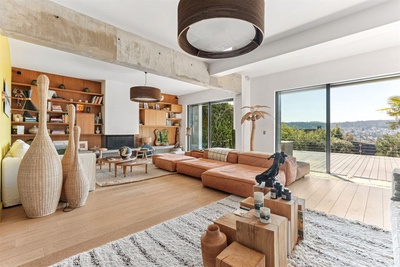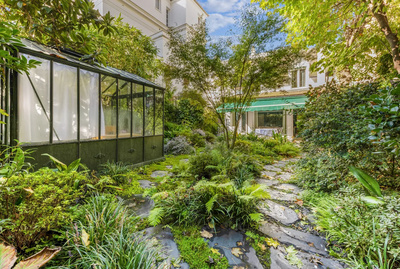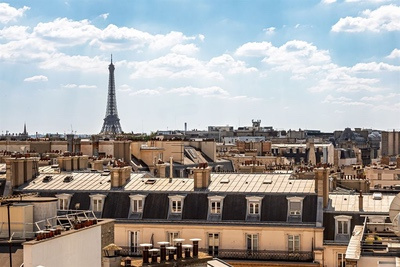Contact us
Paris Ouest (Paris 16ème - Victor Hugo)
Sotheby's International Realty
Sotheby's International Realty
- 138 Avenue Victor Hugo
- 75116 PARIS, France
- +33 1 40 60 50 00
Paris Ouest (Paris 16ème - Auteuil)
Sotheby's International Realty
Sotheby's International Realty
- 50 rue d'Auteuil
- 75016 PARIS, France
- +33 1 56 26 56 55
Paris Ouest (Paris 17ème - Etoile Monceau)
Sotheby's International Realty
Sotheby's International Realty
- 82 Avenue de Wagram
- 75017 PARIS, France
- +33 1 46 22 27 27
Paris Ouest (Neuilly-sur-Seine)
Sotheby's International Realty
Sotheby's International Realty
- Place Sainte Foy - 2 Rue de Chézy
- 92200 NEUILLY, France
- +33 1 41 43 06 46
Paris Ouest (Hauts-de-Seine - Yvelines)
Sotheby's International Realty
Sotheby's International Realty
- Place Sainte Foy - 2 rue de Chézy
- 92200 NEUILLY, France
- +33 1 41 25 00 00
Paris Marais
Sotheby's International Realty
Sotheby's International Realty
- 37-39 rue de Turenne
- 75003 PARIS, France
- +33 1 48 87 14 41
Send an email
Posted on 04/02/2021
In which city to invest in 2021
IDEAL INVESTISSEUR

The Institut de l'Épargne Immobilière et Foncière offers us a classification of Greater Paris into eight groups. This ranking highlights the differences between these districts, according to their potential and attractiveness. This ranking highlights the interest in the Greater Paris East region, a promising area in particular due to the extension of public transport. Indeed, many cities that were previously avoided because of their lack of access to the capital will now be of great interest to the property market. However, transport is not the only criterion, the IEIF relies on 49 variables as well as an evolution over 20 years, which causes a difference between the prestige and attractiveness of these groups. This highlights the "sociological reality" of Greater Paris.
What are these variables? We can cite demographic characteristics such as population growth and organisation, but also sociological characteristics such as age, gender and employment, and the economic criterion is also important (unemployment, salary, type of residence). With these variables, the IEIF has come to the conclusion that despite the new attractiveness of certain sectors, the annual yield is tending to decrease, whereas in 2010 it was 10 to 12% per year, today it is around 2 to 4%.
The number 1 sector: "Paris prime"
Although this sector will not see its prices increase drastically, it is an ideal place to secure your money or buy your main residence. Indeed, although the yields are low, the sector is embellished with its historical character and its prices are among the highest in the Paris area. The residents are mostly senior citizens, and the memorable character of the neighbourhoods prevents many urban development projects. However, this area is favoured by the wealthiest households in the Greater Paris area. Rents have risen by 70% in almost 10 years, while property prices have tripled. The sectors : Paris 5, 6, 7, 8 and 16th arrondissements, Boulogne-Billancourt (92), Neuilly-Sur-Seine (92), Vincennes (94), Saint Mandé (94), Communauté d'agglomération de Versailles Grand Parc (78), Communauté d'agglomération de Saint-Germain en Laye (78)
Sector 2: "Residential Paris"
These districts are on the fringes of the historic centre of Paris, and have shown promise over the last decade. Indeed, the price of stone has quadrupled, while rents have increased by 80%. The area is composed of younger households, with many families and fairly high average incomes. It is a district where the capital gain remains capped but the market is under pressure because there is a lot of demand for few properties available for sale. Sectors : Paris 9, 12, 13, 14, 15, 17th arrondissement, and Levallois-Perret (92).
Sector number 3: "Popular Paris"
This sector could be a good investment, the future seems advantageous for this sector, thanks to the extension of the Grand Paris Express. It is made up of part of the arrondissements to the north of Paris as well as the nearby towns where transport is available. There are numerous urban development projects and a healthy property market, fuelled by a growing population. The annual yield is 3.7%. Sectors : Paris 18 and 19th arrondissements, Asnières sur Seine (92), Suresnes (92), Issy-les-Moulineaux (92), Clichy (92), Montrouge (92), Puteaux (92), Les Lilas (93), Charenton-le-Pont (94), le Kremlin-Bicêtre (94) and Saint-Quentin-en-Yvelines (78).
Sector number 4: "Neo-faubourg"
This is the most advantageous sector for investment. Located in the inner suburbs, many towns tend to stand out from the rest. Stone prices are rising and the neighbourhoods are promising. Once again, the prospect of the Grand Paris Express plays a role in this rise in prices and demand. Nevertheless, these cities are seeing very little increase in the wages of their inhabitants. The sectors : Arcueil (92), Bagneux (92), Gennevilliers (92), Nanterre (92), Colombes (92), Aubervilliers (93), Bagnolet (93), Saint-Ouen (93), Montreuil (93), Pantin (93), Romainville (93), Créteil (94), Alfortville (94), Bonneuil-sur-Marne (94), Ivry-sur-Seine (94), Communauté d'agglomération du Pays de Meaux (77), Communauté d'agglomération Melun Val de Seine (77), Communauté d'agglomération de Cergy-Pontoise (95).
Sector number 5 "Green Paris"
These towns are the refuge of privileged people, generally working in the capital but wishing for the calm of a life in the suburbs. In this sector, houses with gardens and luxury flats flourish. There are few inhabitants in relation to the surface area of the city, so it is a good place to live. This is reflected in the increase in the number of owners and a threefold increase in prices. Also, these cities are popular because they are very well served. The yield is limited to 2.7% over the last decade. The sectors : Rueil-Malmaison (92), Clamart (92), Meudon (92), Sèvres (92), Bourg-la-Reine (92), Chaville (92), Garches (92), Saint-Cloud (92), Sceaux (92), Vaucresson (92), Ville-d'Avray (92), Antony (94), Le Perreux-sur-Marne (94), Nogent-sur-Marne (94), Saint-Maur-des-Fossés (94), Communauté d'agglomération du pays de Fontainebleau (77).
Sector number 6: "Social suburb "
While some professionals promise a potential, the IEIF denies this by certain points. Indeed, this is the least profitable sector. In fact, these neighbourhoods are described as "sensitive", social housing is plentiful and the prospects for salary increases are limited. The investment can be profitable, up to 6% can be envisaged, but this investment is reserved for the most daring people. The sectors : 22 municipalities, including Saint-Denis (93), Drancy (93), Le Blanc-Mesnil (93), Épinay-sur-Seine (93), Bobigny (93), Sevran (93), Bondy (93), Clichy-sous-Bois (93), la Courneuve (93), Neuilly-sur-Marne (93), Noisy-le-Sec (93), Villepinte (93), Orly (94), Vitry-Sur-Seine (94)
Sector number 7 "Dense suburbs
This sector is also limited in terms of development but for different reasons. Indeed, although life is pleasant here because these are suburban areas, the housing is very poorly served. This group is made up of municipalities with a large number of single-family houses, and therefore a large number of families. Some of them are quite far from public transport, the average income in these areas does not increase very much and the demographic growth is often negative. After an increase in prices, the latter have stabilised, and the yield remains limited. The sectors : 23 municipalities including Viry-Châtillon (91), le Bourget (93), Montfermeil (93), Noisy-le-Grand (93), Aulnay-sous-Bois (93), Gagny (93), Champigny-sur-Marne (94), Juvisy-sur-Orge (94), Argenteuil (95).
Sector number 8: The "Urban Periphery"
Finally, the last category concerns all the towns that are too far away to be included in the Grand Paris project. Prices do not rise sharply, nor does the demography. Yields are also fairly low. The sectors : Val Parisis (Ermont, Beauchamps, Francoville...), Coeur d'Essonne (Sainte-Geneviève des Bois, Brétigny, Saint-Germain-lès-Arpajon...), Val d'Yerres Val de Seine (Brunoy, Draveil, Montgeron...), Etampois Sud-Essonne, Marne et Gondoire...
To read the full article, click here.
Paris West Sotheby's International Realty, expert in luxury and prestige real estate in Paris
What are these variables? We can cite demographic characteristics such as population growth and organisation, but also sociological characteristics such as age, gender and employment, and the economic criterion is also important (unemployment, salary, type of residence). With these variables, the IEIF has come to the conclusion that despite the new attractiveness of certain sectors, the annual yield is tending to decrease, whereas in 2010 it was 10 to 12% per year, today it is around 2 to 4%.
The number 1 sector: "Paris prime"
Although this sector will not see its prices increase drastically, it is an ideal place to secure your money or buy your main residence. Indeed, although the yields are low, the sector is embellished with its historical character and its prices are among the highest in the Paris area. The residents are mostly senior citizens, and the memorable character of the neighbourhoods prevents many urban development projects. However, this area is favoured by the wealthiest households in the Greater Paris area. Rents have risen by 70% in almost 10 years, while property prices have tripled. The sectors : Paris 5, 6, 7, 8 and 16th arrondissements, Boulogne-Billancourt (92), Neuilly-Sur-Seine (92), Vincennes (94), Saint Mandé (94), Communauté d'agglomération de Versailles Grand Parc (78), Communauté d'agglomération de Saint-Germain en Laye (78)
Sector 2: "Residential Paris"
These districts are on the fringes of the historic centre of Paris, and have shown promise over the last decade. Indeed, the price of stone has quadrupled, while rents have increased by 80%. The area is composed of younger households, with many families and fairly high average incomes. It is a district where the capital gain remains capped but the market is under pressure because there is a lot of demand for few properties available for sale. Sectors : Paris 9, 12, 13, 14, 15, 17th arrondissement, and Levallois-Perret (92).
Sector number 3: "Popular Paris"
This sector could be a good investment, the future seems advantageous for this sector, thanks to the extension of the Grand Paris Express. It is made up of part of the arrondissements to the north of Paris as well as the nearby towns where transport is available. There are numerous urban development projects and a healthy property market, fuelled by a growing population. The annual yield is 3.7%. Sectors : Paris 18 and 19th arrondissements, Asnières sur Seine (92), Suresnes (92), Issy-les-Moulineaux (92), Clichy (92), Montrouge (92), Puteaux (92), Les Lilas (93), Charenton-le-Pont (94), le Kremlin-Bicêtre (94) and Saint-Quentin-en-Yvelines (78).
Sector number 4: "Neo-faubourg"
This is the most advantageous sector for investment. Located in the inner suburbs, many towns tend to stand out from the rest. Stone prices are rising and the neighbourhoods are promising. Once again, the prospect of the Grand Paris Express plays a role in this rise in prices and demand. Nevertheless, these cities are seeing very little increase in the wages of their inhabitants. The sectors : Arcueil (92), Bagneux (92), Gennevilliers (92), Nanterre (92), Colombes (92), Aubervilliers (93), Bagnolet (93), Saint-Ouen (93), Montreuil (93), Pantin (93), Romainville (93), Créteil (94), Alfortville (94), Bonneuil-sur-Marne (94), Ivry-sur-Seine (94), Communauté d'agglomération du Pays de Meaux (77), Communauté d'agglomération Melun Val de Seine (77), Communauté d'agglomération de Cergy-Pontoise (95).
Sector number 5 "Green Paris"
These towns are the refuge of privileged people, generally working in the capital but wishing for the calm of a life in the suburbs. In this sector, houses with gardens and luxury flats flourish. There are few inhabitants in relation to the surface area of the city, so it is a good place to live. This is reflected in the increase in the number of owners and a threefold increase in prices. Also, these cities are popular because they are very well served. The yield is limited to 2.7% over the last decade. The sectors : Rueil-Malmaison (92), Clamart (92), Meudon (92), Sèvres (92), Bourg-la-Reine (92), Chaville (92), Garches (92), Saint-Cloud (92), Sceaux (92), Vaucresson (92), Ville-d'Avray (92), Antony (94), Le Perreux-sur-Marne (94), Nogent-sur-Marne (94), Saint-Maur-des-Fossés (94), Communauté d'agglomération du pays de Fontainebleau (77).
Sector number 6: "Social suburb "
While some professionals promise a potential, the IEIF denies this by certain points. Indeed, this is the least profitable sector. In fact, these neighbourhoods are described as "sensitive", social housing is plentiful and the prospects for salary increases are limited. The investment can be profitable, up to 6% can be envisaged, but this investment is reserved for the most daring people. The sectors : 22 municipalities, including Saint-Denis (93), Drancy (93), Le Blanc-Mesnil (93), Épinay-sur-Seine (93), Bobigny (93), Sevran (93), Bondy (93), Clichy-sous-Bois (93), la Courneuve (93), Neuilly-sur-Marne (93), Noisy-le-Sec (93), Villepinte (93), Orly (94), Vitry-Sur-Seine (94)
Sector number 7 "Dense suburbs
This sector is also limited in terms of development but for different reasons. Indeed, although life is pleasant here because these are suburban areas, the housing is very poorly served. This group is made up of municipalities with a large number of single-family houses, and therefore a large number of families. Some of them are quite far from public transport, the average income in these areas does not increase very much and the demographic growth is often negative. After an increase in prices, the latter have stabilised, and the yield remains limited. The sectors : 23 municipalities including Viry-Châtillon (91), le Bourget (93), Montfermeil (93), Noisy-le-Grand (93), Aulnay-sous-Bois (93), Gagny (93), Champigny-sur-Marne (94), Juvisy-sur-Orge (94), Argenteuil (95).
Sector number 8: The "Urban Periphery"
Finally, the last category concerns all the towns that are too far away to be included in the Grand Paris project. Prices do not rise sharply, nor does the demography. Yields are also fairly low. The sectors : Val Parisis (Ermont, Beauchamps, Francoville...), Coeur d'Essonne (Sainte-Geneviève des Bois, Brétigny, Saint-Germain-lès-Arpajon...), Val d'Yerres Val de Seine (Brunoy, Draveil, Montgeron...), Etampois Sud-Essonne, Marne et Gondoire...
To read the full article, click here.
Paris West Sotheby's International Realty, expert in luxury and prestige real estate in Paris
The latest articles







